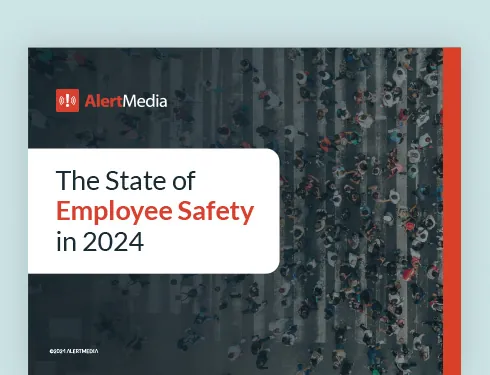
Navigating a Safe and Stable Return to the Workplace [Webinar Recap]
Environmental Health and Safety Attorney, Chris Schlag, provides insights into addressing and complying with regulation changes for organizations developing their reopening plans.

As COVID-19 pandemic circumstances improve in the U.S., how and when to return to the workplace is top of mind for many organizations.
To address those questions, AlertMedia recently hosted a webinar in partnership with Risk and Resilience Hub tackling the topic: Navigating a Safe and Stable Return to the Workplace. Our featured guest speaker was Chris Schlag, an Environmental Health and Safety Attorney at Jackson Lewis, P.C., who has more than a decade’s worth of experience counseling and working with employers on a broad range of environmental health and safety matters.
During the webinar, Chris guided the audience through the latest regulation changes from government agencies, provided insights for adjusting company safety procedures, and discussed best practices for developing vaccine policies.
Chris was joined by Peter Steinfeld, SVP of Safety Solutions at AlertMedia, who explained how the current phase of the pandemic is impacting reopening plans for many businesses and the logistical, operational, and financial challenges that organizations should consider. He also offered suggestions on how companies can effectively communicate their reopening plans to employees and stakeholders.
If you missed the webinar, you can access the recording here.
(Editorial Note: Pandemic circumstances and agency guidelines change frequently. Please refer to your state and local agency resources to find the most current and accurate information. Chris’s guidance is for informational purposes only and should not be construed as legal advice.)
How the Pandemic Is Impacting Reopening Plans
Pandemic circumstances are a huge consideration for businesses as they develop their plans to return to the workplace. While change is still constant in this current phase, the situation appears promising, and there is finally light at the end of the tunnel.
Most Americans have now received at least one dose of the COVID-19 vaccine. As of May 24, 2021, 40 percent of U.S. adults are fully vaccinated. This steady increase in vaccination rates is good for public health and welcome news for many companies that have eagerly awaited a signal that their workforce can be brought back to the office safely.
However, as organizations contemplate their reopening plans, numerous logistical, operational, and financial considerations remain.
Logistical, operational, and financial considerations
The number of factors that companies must consider to reopen successfully can be overwhelming. Peter suggests taking a bird’s eye view of these factors first, then focusing on which ones apply to your organization before prioritizing and addressing them. These considerations include:
- Which personnel will return to the office?
- When and how will you keep track of employees returning to the office?
- Will your plan address facility needs, such as renewing leases, sanitation protocols, seating arrangements, and public spaces?
- Is work travel still necessary? If so, will the cadence be the same as pre-pandemic times?
- Will you need to implement new protocols such as symptom screenings or temperature checks?
- How will your plan affect the company culture?
Outside of the everyday operational considerations, organizations must also consider what is best for their people.
Prioritizing employee health and safety
No matter if or when employees return to the workplace, employers must continue to fulfill their duty of care. Businesses should not overlook employee retention and well-being. Instead, they should be a top priority.
After a year or more of uncertainty, employees are voicing their opinions about returning to the workplace. Those opinions vary based on age, region, health, political preferences, and personal circumstances. Employers should not assume that an employee’s circumstances remain the same as they were pre-pandemic. Leadership should solicit feedback from their employees and take that feedback to heart. After all, employees are humans, not robots, and they have been through a great deal of stress due to the pandemic.
Addressing Regulation Changes and Adjusting Safety Policies
When it comes to complying with regulatory changes and creating new policies to protect your people, employers must understand the current legal landscape. Chris provided our webinar audience with a framework of the health and safety regulations that they should consider as they develop their reopening plans.
The framework
Chris described the “regulatory layers” of government agencies that employers are subject to and how an enforcement initiative like COVID-19 could mean an increase in complaints, warnings, violations, or investigations. This formula best describes it:
This will be new territory for many organizations that have no experience with OSHA, EPA, or any other agencies because they are office-based and considered low-hazard. Still, due to the virus, ALL businesses now have increased hazards.
She suggested that employers NOT rely solely on CDC guidance as they develop their reopening plans. While the public health aspect of the pandemic is driven by CDC guidance, federal, state, and local agencies are responsible for workplace health and safety regulations.
Chris tackled other vital topics within the framework, ranging from deciphering conflicting guidance from government agencies to determining the difference between a recommendation and what can be legally enforced.
Vaccine policies
Many webinar attendees were surprised to learn that not all organizations need a vaccine policy. It depends on each company’s circumstances, industry, and location.
In fact, it is only because agencies classify COVID-19 (or any pandemic) as a “direct threat” that employers can inquire about their employees’ vaccination or health status at all. If the virus is no longer considered a direct threat, the regulations could change.
Chris addressed other vaccine policy considerations, such as risk mitigation strategies and criteria for determining whether a company should mandate—or strongly encourage—vaccines.
Preparing your workplace for a “new normal”
The pandemic has fundamentally changed how we conduct business, where work takes place, and how we safeguard our people. With this in mind, Chris offered several policy ideas and resources that companies should consider implementing to help their people prepare for a “new normal.”
Organizations should consider:
- Revised sick leave policies / increased sick days
- Flexible remote work policies
- Offering proactive health benefits such as mental health resources or gym memberships
- Reinvented company event guidelines
- Ways to solicit employee feedback
Most importantly, Chris advised that every company consult with or retain a legal professional to help them make heads or tails of these regulatory shifts and ensure their employees are healthy, safe, and productive.
To hear all of Chris’s valuable insights, watch the webinar now.
Best Practices for Communicating Your Reopening Plan
Understanding and complying with government agency regulations are essential, but so is proper communication. Efficient and effective communication is paramount to a successful return to the workplace. Peter offered these tips for developing clear communication strategies to help your people feel supported and safe as they transition back to in-person work:
- Be transparent — share a fully documented plan across multiple channels, and explain the “why” behind it.
- Implement a transition team — assemble a group of employees across the business that can assess and manage challenges, report to leadership, and communicate solutions to employees.
- Utilize a modern mass notification system — make sharing reopening plans and notifying employees of changes simple with an easy-to-use tool such as AlertMedia.
The Big Picture
As companies cautiously approach their return to the workplace, they should understand that everything is subject to change: agency guidelines and regulations, pandemic circumstances, company policies and procedures, and employee needs and preferences. Organizations that create a comprehensive reopening plan, communicate it effectively, and remain flexible will position themselves for success.
To learn more about navigating a safe and stable return to the workplace and how AlertMedia can help, watch the entire on-demand webinar.



![Enhancing Employee Safety for Remote Workers [Webinar Recap]](https://www.alertmedia.com/wp-content/uploads/2021/03/Blog-EvolvingSafetyAnywhereWorker-WebinarRecap.jpg)
